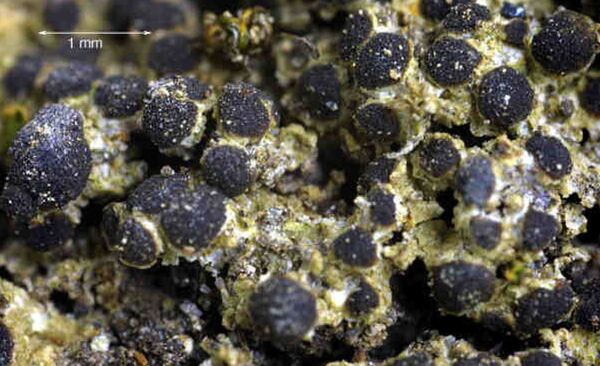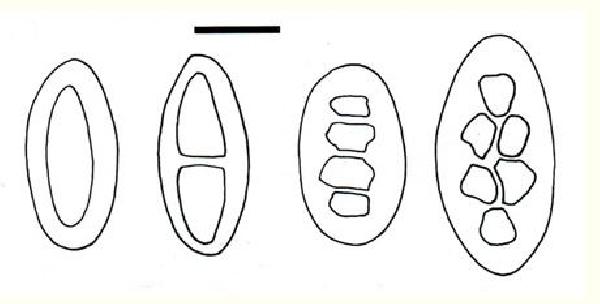Rinodina intermedia Bagl.
Comm. Soc. Critt. Ital., 1: 313, 1863.
Synonyms: Psora turfacea f. ligustica Rabenh.; Rinodina lusitanica Arnold
Distribution: N - TAA, Lig.
Description: Thallus crustose to subsquamulose, episubstratic, thick to thin and evanescent, usually pale grey-green, ochraceous or pale brown, without a distinct prothallus. Apothecia lecanorine, subimmersed to adnate, rarely sessile, 0.5-1 mm across, with a dark brown to black, flat to convex disc, and a thin, entire and persistent, rarely poorly developed thalline margin. Thalline exciple 70-120 µm wide laterally, corticate, the cortex overlain by an epinecral layer; proper exciple colourless, 10-20 µm wide laterally, expanding to 30-80 µm in upper part; epithecium orange-brown, K-; hymenium colourless, 100-150 µm high; paraphyses richly branched and anastomosing in upper part, 2-3 µm thick at mid-level, the apical cells 3-5 µm wide, immersed in dispersed pigment; hypothecium colourless or pale yellowish brown, 90-120 µm high. Asci 8-spored, clavate, the K/I+ blue tholus penetrated by a faintly amyloid apical cushion with parallel or diverging flanks, the wall K/I-, surrounded by a K/I+ blue outer layer, Lecanora-type. Ascospores at first 1-3-septate, then submuriform and up to 6-celled, brown, ellipsoid, with irregularly rounded locules, (21-)24-32(-36) x (10-)12-14(-16) µm, the ontogeny of type A (apical wall thickening after septum formation). Pycnidia dark, pear-shaped, immersed. Conidia bacilliform, 3.5-4 µm long. Photobiont chlorococcoid. Spot tests: K- or K+ rose-violet, C-, KC-, P-. Chemistry: deoxylichesterinic acid, sometimes traces of skyrin, graciliformin, and pannarin.Note: a widespread species reported from Asia, Central and South America, Europe and Africa, including the Canary Islands and the Cape Verde Islands, found on soil and mosses over basic siliceous substrata, in open grasslands and garrigue vegetation.
Growth form: Crustose
Substrata: soil, terricolous mosses, and plant debris
Photobiont: green algae other than Trentepohlia
Reproductive strategy: mainly sexual
Most common in areas with a humid-warm climate (e.g. most of Tyrrenian Italy)
Commonnes-rarity: (info)
Alpine belt: absent
Subalpine belt: absent
Oromediterranean belt: absent
Montane belt: absent
Submediterranean belt: extremely rare
Padanian area: absent
Humid submediterranean belt: very rare
Humid mediterranean belt: very rare
Dry mediterranean belt: absent
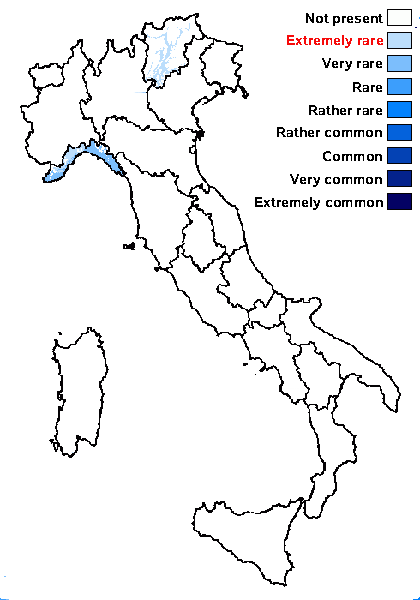
Predictive model
Herbarium samples
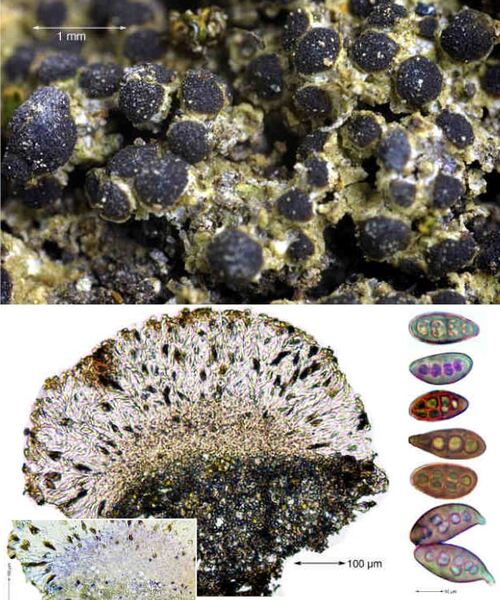

Felix Schumm – CC BY-SA 4.0
Image from: F. Schumm (2008) - Flechten Madeiras, der Kanaren und Azoren. Beck, OHG - ISBN: 978-3-00-023700-3


P.L. Nimis; Owner: Department of Life Sciences, University of Trieste
Herbarium: TSB (4759)
2002/05/13


P.L. Nimis; Owner: Department of Life Sciences, University of Trieste
Herbarium: TSB (4759)
2002/05/13
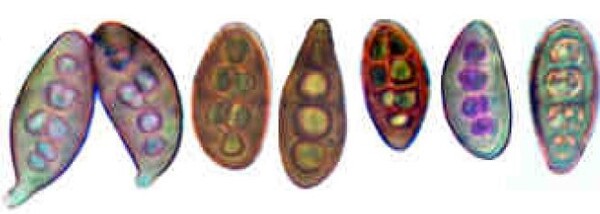

Felix Schumm - CC BY-SA 4.0; Owner: Image from: F. Schumm (2008) - Flechten Madeiras, der Kanaren und Azoren. Beck, OHG - ISBN: 978-3-00-023700-3
Growth form: Crustose
Substrata: soil, terricolous mosses, and plant debris
Photobiont: green algae other than Trentepohlia
Reproductive strategy: mainly sexual
Most common in areas with a humid-warm climate (e.g. most of Tyrrenian Italy)
Commonnes-rarity: (info)
Alpine belt: absent
Subalpine belt: absent
Oromediterranean belt: absent
Montane belt: absent
Submediterranean belt: extremely rare
Padanian area: absent
Humid submediterranean belt: very rare
Humid mediterranean belt: very rare
Dry mediterranean belt: absent

Predictive model
| Herbarium samples |


Felix Schumm – CC BY-SA 4.0
Image from: F. Schumm (2008) - Flechten Madeiras, der Kanaren und Azoren. Beck, OHG - ISBN: 978-3-00-023700-3


P.L. Nimis; Owner: Department of Life Sciences, University of Trieste
Herbarium: TSB (4759)
2002/05/13


P.L. Nimis; Owner: Department of Life Sciences, University of Trieste
Herbarium: TSB (4759)
2002/05/13


 INDEX FUNGORUM
INDEX FUNGORUM
 GBIF
GBIF
 DOLICHENS
DOLICHENS
